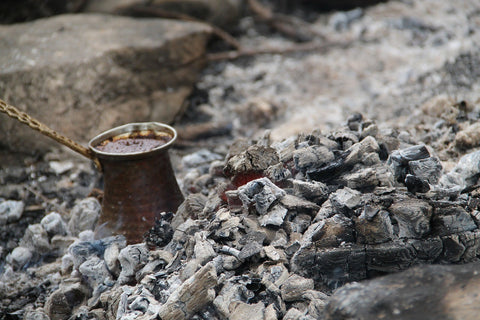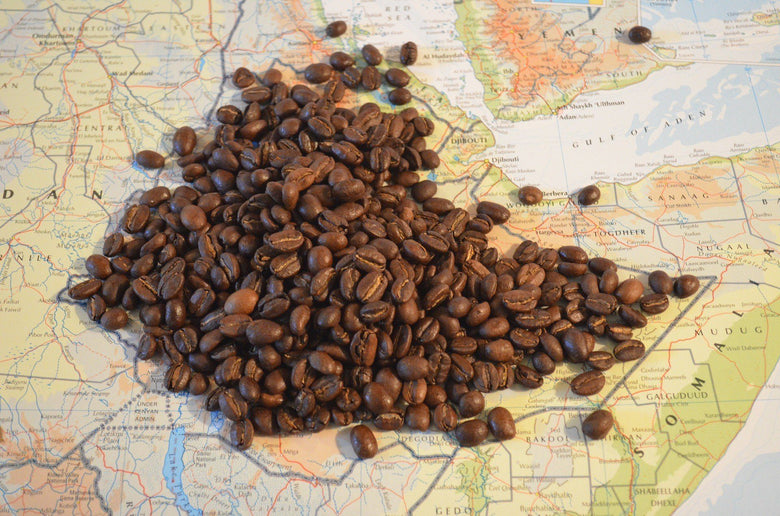To many of us, coffee is so essential to life that it’s unimaginable that it wasn’t enjoyed as a beverage at one point in history. But, the reality is, coffee is a fairly new thing compared to the history of the world.
Tea and alcohol, for example, have been around for 5,000+ years. Coffee, on the other hand, has only been enjoyed in drink form for a little over 1,000, but we can only verify its existence as far back as 500 years ago.
Despite being a short history, it’s a fascinating one.
Scandal, revolution, slavery, colonization - these storybook themes are big in coffee’s history. This isn’t a boring textbook history.
Let me tell you the story of coffee.
Read: The Incredible Journey Of The Coffee Bean (Seed To Cup)
There’s Always A Legend
Coffee’s history doesn’t begin on any specific date. It begins with a legend.
Kaldi, an Ethiopian herdsman from Kaffa, was tending to his goats. He noticed that some of them were behaving abnorormally, jumping wildly and yelling. He realized that the energetic goats were eating small red berries.
He tried one himself and felt energized quickly. He stuffed his pockets with some berries and took them to his wife, who counseled him to take the “heaven sent” berries to the nearby monastery.
However, the monks were not so excited. They tossed the berries into the fire, believing them to be a trick of the Devil. However, as the seeds within roasted in the fire, the rich aromas caught the curiosity of the monks.
They collected the roasted coffee beans from the fire, ground them into small pieces, and tossed them in some hot water. They tried the brew, and the rest is history.
Read: Why You Need To Be Drinking Coffee Black (And How To Start)
There’s no way to know how true this story is, or when exactly the events may have taken place (many estimate around 850 AD). But what’s the fun in a legend if the story can be proven?
There are other origin tales, all centered around Ethiopia and Yemen, though this one is the most told and beloved.
Things get a little more clear, though not perfectly, in the next phase of this story.
Yemeni Natives, Our Coffee Heroes
The earliest credible sources of coffee mentioned as a beverage comes from Sufi monasteries in Yemen in the 15th century, though there’s reason to believe non-Muslim Arabians had been making wine with the coffee cherries for over 200 years already.
One version of the story says that Yemeni traders came to Istanbul and set up a coffee shop similar to ones they frequented in the Yemeni port of Mocha, and the new drink spread like wildfire.
Another version says the Ottoman governor of Yemen discovered coffee in a local coffee shop and had it immediately sent to the Sultan, who fell in love at first sip.
Read: Want To Be A Coffee Aficionado? Here Are 5 Things You Need To Know
Once again, neither of these stories can be verified completely, but there are a few things we do know for certain about this time period.
- By the mid-1550’s, coffee was rapidly spreading around the Arabian Peninsula and North-East Africa.
- An Ottoman Sultan’s blessing is largely responsible for its widespread enjoyment.
Coffee houses became the hubs for conversations and gatherings throughout Egypt, Syria, and Ethiopia. Coffee was so central to Ottoman life, that if a wife could not brew good coffee (made via the Turkish Coffee Method), it was suitable grounds for the man to divorce her.

There were a few attempts by Muslim clergy to ban the drinking of coffee. They feared that, like with wine, it would keep the religious adherents from being in their right mind. However, each time the ruling was overturned. Coffee was too good.
One governor of Mecca even closed down all of the coffee houses he could, for they were a place where his political opposition would meet and spread ideas. After many riots, the Ottoman Sultan had him executed, and coffee houses restored.
Read: 5 Ways To Make Your Coffee More Eco-Friendly
With thousands of annual visitors to Mecca, and with coffee being so pervasive in society, it was only a matter of time before coffee spread beyond Africa and Arabia.
Coffee Goes To Europe
Coffee probably arrived in Europe first through Turkish slaves in Malta, though, being an island, it wasn’t a great launching point for further coffee expansion. When coffee found its way to The Republic of Venice, however, it became an unstoppable force.
In 1615, coffee was a new product sold by street side lemonade vendors.
Some of the local clergy condemned coffee, calling it a “bitter invention of Satan” (sound familiar?). The debate was so lively that Pope Clement VIII became involved. When he tasted the coffee himself, he quickly gave his approval and claimed it was a gift from above.
By 1645, coffee houses were all over Italy. Over the next 30 years, coffee became cultural staples in Austria, France, Germany England, and the rest of Europe. By the end of the 1600’s, London is said to have contained over 300 coffee houses.
Read: Why You Should Ditch Your Drip Coffee Pot For A French Press
The Great Expansion
Coffee, even with its rapid growth over just a couple hundred years, was just getting started. Now that it was in the hands of the world’s soon-to-be colonizing nations, its fame would grow at its most stunning rate yet.
The Dutch loved drinking coffee, but they saw it as a large-scale business opportunity more quickly than the rest of Europe. By 1699, Dutch traders had taken coffee to Java, Indonesia, which became the second commercially available coffee in the world.
Other countries saw the success of the Dutch and were quick to follow suit.
In 1720, Gabriel de Clieu, a French naval officer, brought coffee seeds to the Caribbean island of Martinique, Haiti, and Mexico. With the power of slave labor, coffee grown in the New World became enormously profitable, causing it to spread into other areas of the Americas.
The famous Boston Tea Party in the British Colonies signaled the end of the New World’s dependence on tea, and coffee reached a new level of popularity. By the 1800’s, coffee was growing in Jamaica, South East Asia, and many Pacific islands. It was big business.
Read: What Does A Coffee Roaster Actually Do?
Brazil became the world’s leading coffee producer in the 1800’s, at one point producing 80% of the world’s beans. Vietnam became the world’s second-largest producer, followed by Colombia and Venezuela.
By 1850, every corner of the world was drinking coffee.
Modern Coffee
Coffee is the second most traded commodity in the world, behind only oil. It’s a part of everyone’s life, even people who don’t drink it.
Thankfully, coffee isn’t grown by slaves anymore. Though, sadly, the economic condition of many coffee producing communities is still in rough shape.
In the 1990’s, a new movement began to arise in the United States of America. Roasters began roasting coffee lighter, brewing coffee by hand, and educating customers on the origins of the beans.

This evolved into what we know as the specialty coffee industry, which, in just a couple short decades, grew to be a worldwide movement.
In the USA alone, the specialty coffee segment has become the largest coffee industry segment, beating out the “2nd Wave Coffee” that includes Starbucks, Peets, and many others.
Specialty coffee highlights the beans unique characteristics, strives to uplift farmers from poor conditions, and hopes to make coffee sustainable.
Coffee’s come a long way, and the journey has reaped some delicious rewards.
Coffee’s history has led to this new, quality-focused style of coffee.


